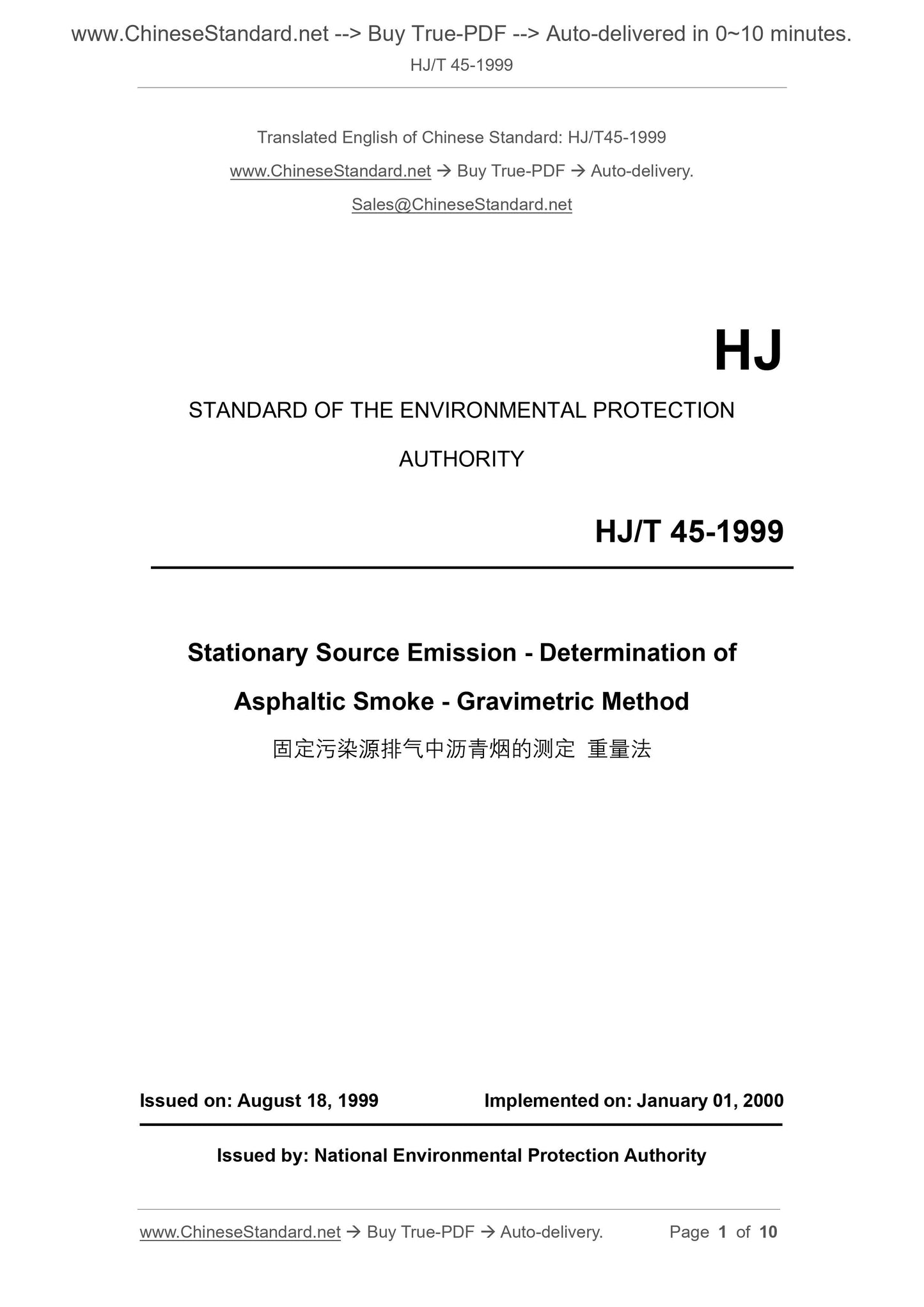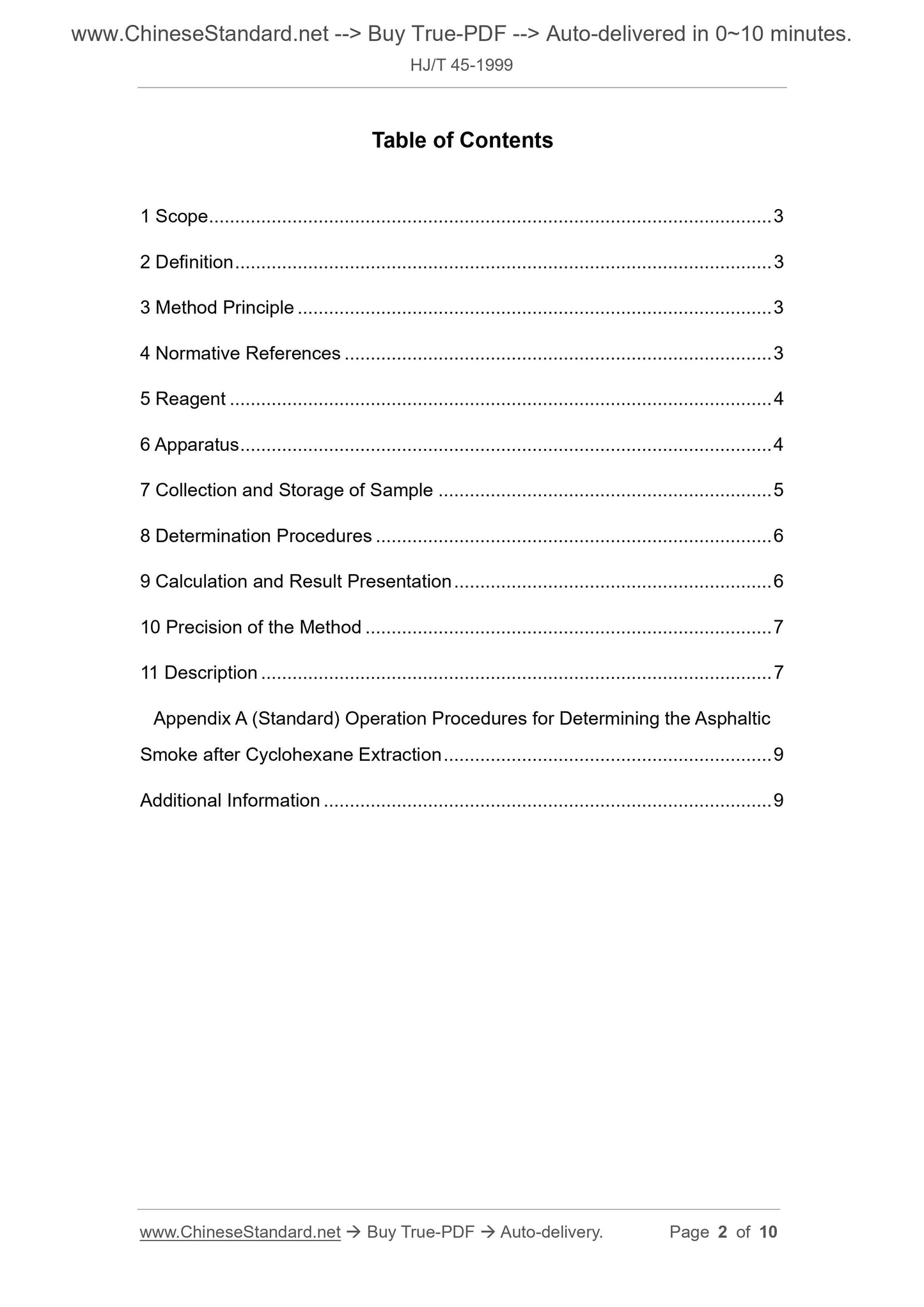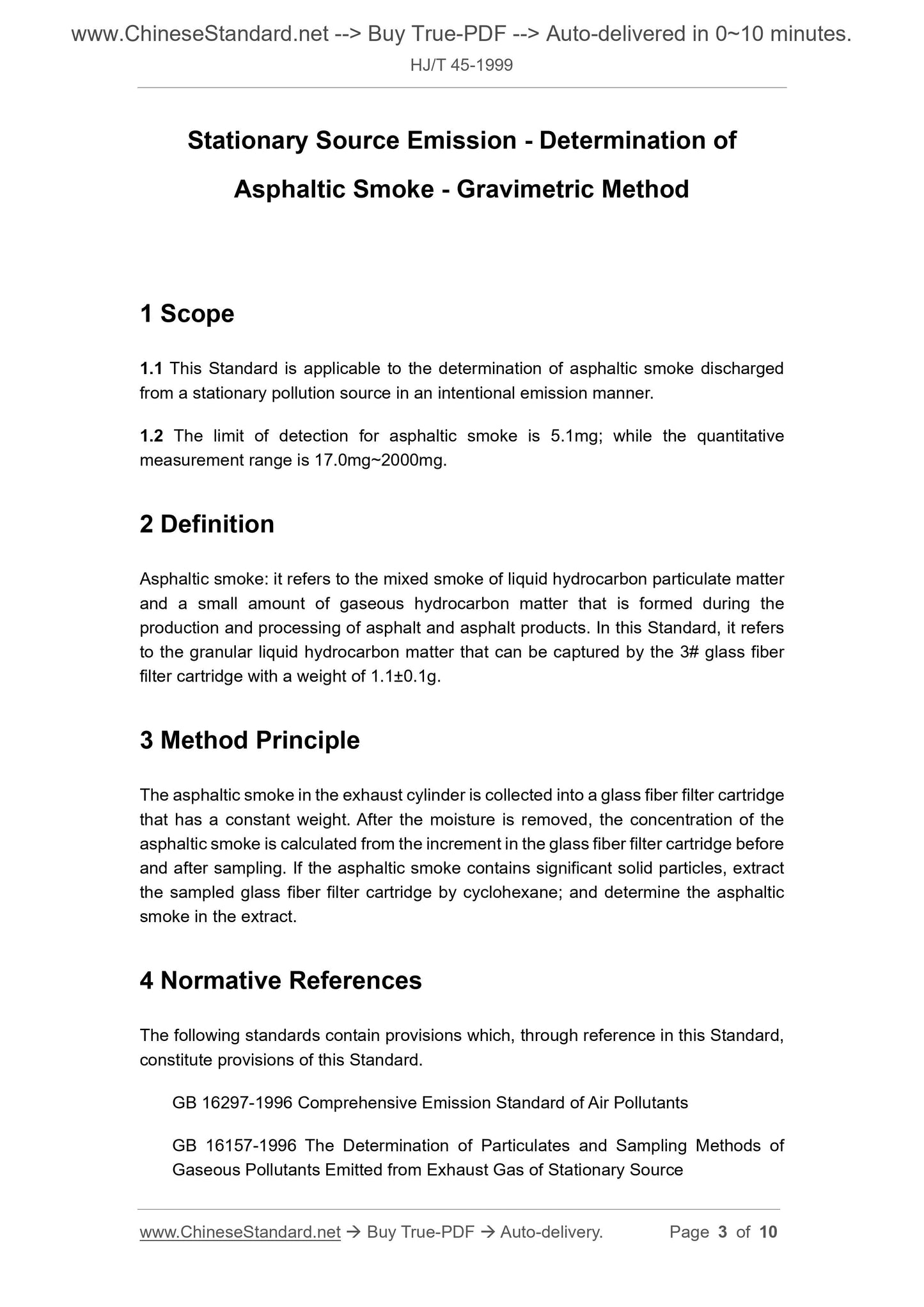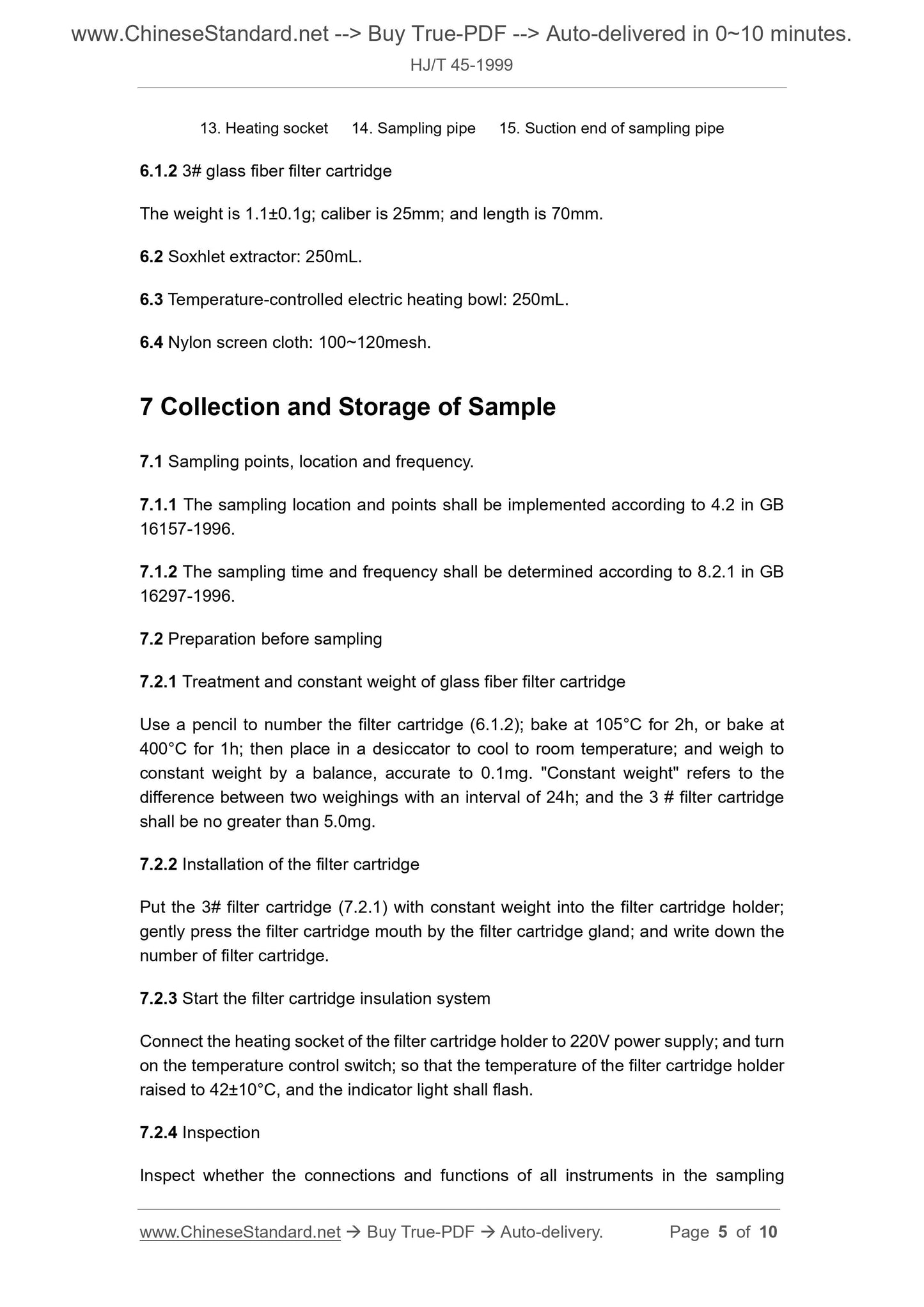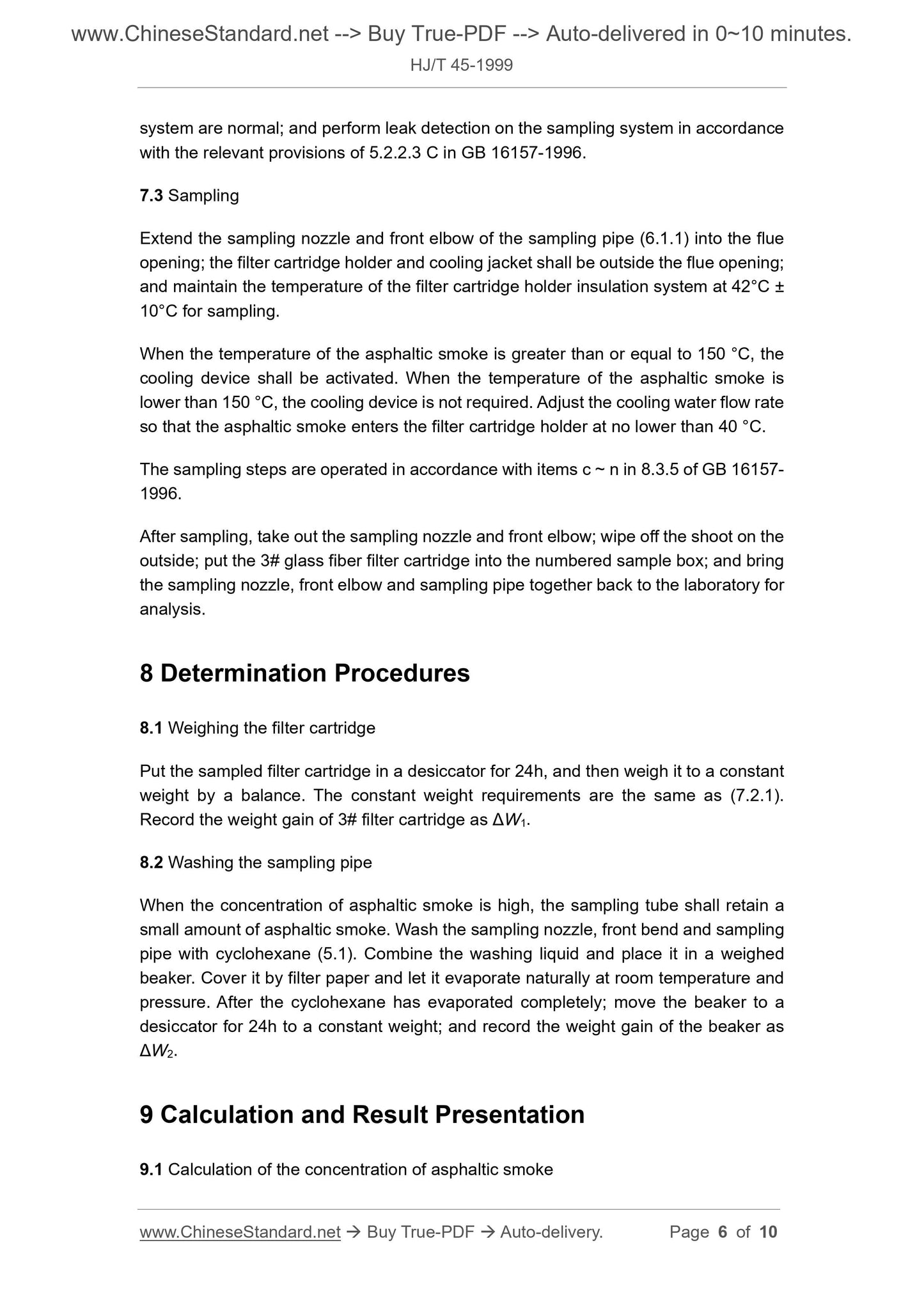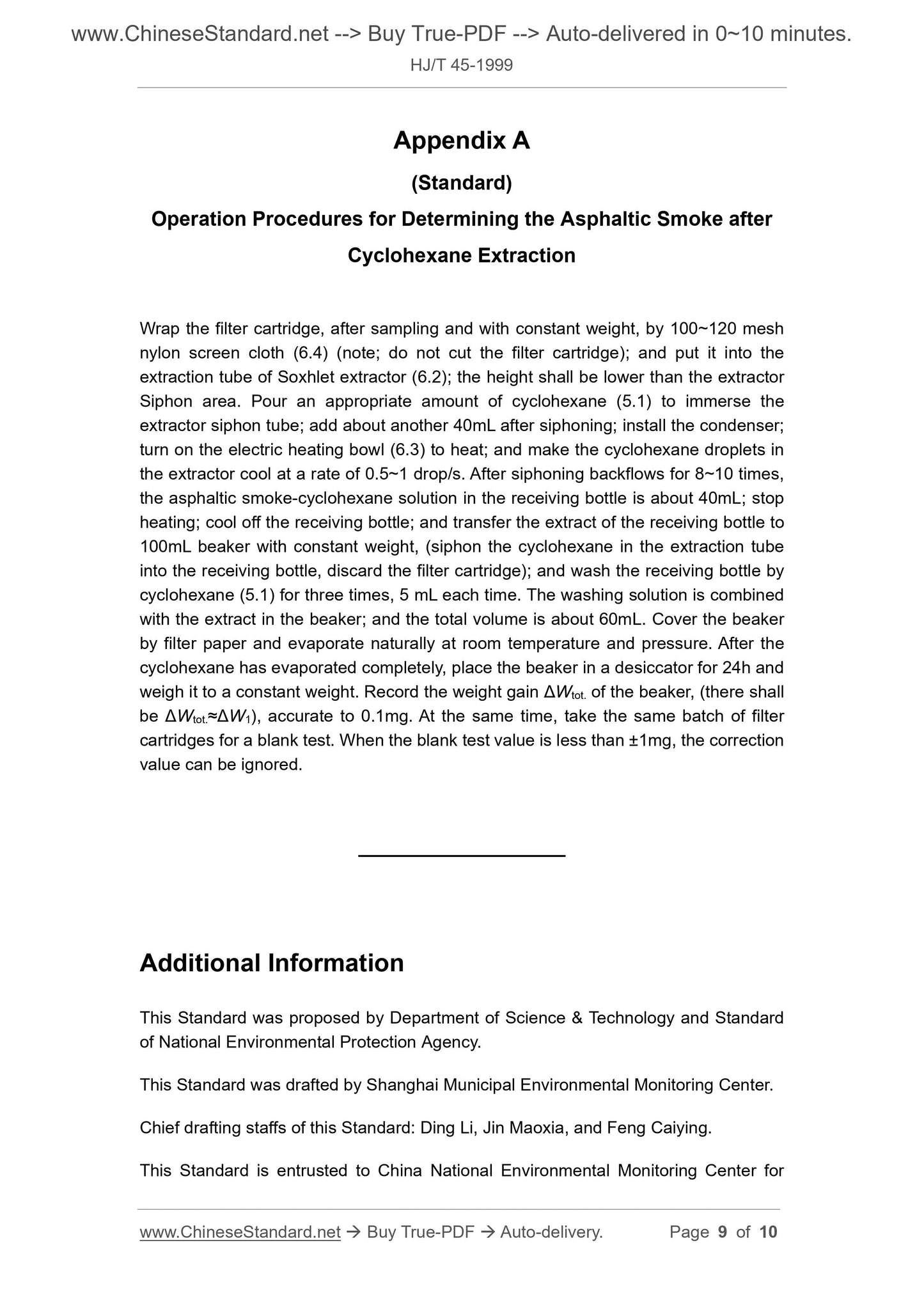1
/
of
6
www.ChineseStandard.us -- Field Test Asia Pte. Ltd.
HJ/T 45-1999 English PDF (HJ/T45-1999)
HJ/T 45-1999 English PDF (HJ/T45-1999)
Regular price
$160.00
Regular price
Sale price
$160.00
Unit price
/
per
Shipping calculated at checkout.
Couldn't load pickup availability
HJ/T 45-1999: Stationary source emission. Determination of asphaltic smoke. Gravimetric method
Delivery: 9 seconds. Download (& Email) true-PDF + Invoice.
Get Quotation: Click HJ/T 45-1999 (Self-service in 1-minute)
Historical versions (Master-website): HJ/T 45-1999
Preview True-PDF (Reload/Scroll-down if blank)
HJ/T 45-1999
HJ
STANDARD OF THE ENVIRONMENTAL PROTECTION
AUTHORITY
Stationary Source Emission - Determination of
Asphaltic Smoke - Gravimetric Method
ISSUED ON: AUGUST 18, 1999
IMPLEMENTED ON: JANUARY 01, 2000
Issued by: National Environmental Protection Authority
Table of Contents
1 Scope ... 3
2 Definition ... 3
3 Method Principle ... 3
4 Normative References ... 3
5 Reagent ... 4
6 Apparatus ... 4
7 Collection and Storage of Sample ... 5
8 Determination Procedures ... 6
9 Calculation and Result Presentation ... 6
10 Precision of the Method ... 7
11 Description ... 7
Appendix A (Standard) Operation Procedures for Determining the Asphaltic
Smoke after Cyclohexane Extraction ... 9
Additional Information ... 9
Stationary Source Emission - Determination of
Asphaltic Smoke - Gravimetric Method
1 Scope
1.1 This Standard is applicable to the determination of asphaltic smoke discharged
from a stationary pollution source in an intentional emission manner.
1.2 The limit of detection for asphaltic smoke is 5.1mg; while the quantitative
measurement range is 17.0mg~2000mg.
2 Definition
Asphaltic smoke: it refers to the mixed smoke of liquid hydrocarbon particulate matter
and a small amount of gaseous hydrocarbon matter that is formed during the
production and processing of asphalt and asphalt products. In this Standard, it refers
to the granular liquid hydrocarbon matter that can be captured by the 3# glass fiber
filter cartridge with a weight of 1.1±0.1g.
3 Method Principle
The asphaltic smoke in the exhaust cylinder is collected into a glass fiber filter cartridge
that has a constant weight. After the moisture is removed, the concentration of the
asphaltic smoke is calculated from the increment in the glass fiber filter cartridge before
and after sampling. If the asphaltic smoke contains significant solid particles, extract
the sampled glass fiber filter cartridge by cyclohexane; and determine the asphaltic
smoke in the extract.
4 Normative References
The following standards contain provisions which, through reference in this Standard,
constitute provisions of this Standard.
GB 16297-1996 Comprehensive Emission Standard of Air Pollutants
GB 16157-1996 The Determination of Particulates and Sampling Methods of
Gaseous Pollutants Emitted from Exhaust Gas of Stationary Source
13. Heating socket 14. Sampling pipe 15. Suction end of sampling pipe
6.1.2 3# glass fiber filter cartridge
The weight is 1.1±0.1g; caliber is 25mm; and length is 70mm.
6.2 Soxhlet extractor: 250mL.
6.3 Temperature-controlled electric heating bowl: 250mL.
6.4 Nylon screen cloth: 100~120mesh.
7 Collection and Storage of Sample
7.1 Sampling points, location and frequency.
7.1.1 The sampling location and points shall be implemented according to 4.2 in GB
16157-1996.
7.1.2 The sampling time and frequency shall be determined according to 8.2.1 in GB
16297-1996.
7.2 Preparation before sampling
7.2.1 Treatment and constant weight of glass fiber filter cartridge
Use a pencil to number the filter cartridge (6.1.2); bake at 105°C for 2h, or bake at
400°C for 1h; then place in a desiccator to cool to room temperature; and weigh to
constant weight by a balance, accurate to 0.1mg. "Constant weight" refers to the
difference between two weighings with an interval of 24h; and the 3 # filter cartridge
shall be no greater than 5.0mg.
7.2.2 Installation of the filter cartridge
Put the 3# filter cartridge (7.2.1) with constant weight into the filter cartridge holder;
gently press the filter cartridge mouth by the filter cartridge gland; and write down the
number of filter cartridge.
7.2.3 Start the filter cartridge insulation system
Connect the heating socket of the filter cartridge holder to 220V power supply; and turn
on the temperature control switch; so that the temperature of the filter cartridge holder
raised to 42±10°C, and the indicator light shall flash.
7.2.4 Inspection
Inspect whether the connections and functions of all instruments in the sampling
system are normal; and perform leak detection on the sampling system in accordance
with the relevant provisions of 5.2.2.3 C in GB 16157-1996.
7.3 Sampling
Extend the sampling nozzle and front elbow of the sampling pipe (6.1.1) into the flue
opening; the filter cartridge holder and cooling jacket shall be outside the flue opening;
and maintain the temperature of the filter cartridge holder insulation system at 42°C ±
10°C for sampling.
When the temperature of the asphaltic smoke is greater than or equal to 150 °C, the
cooling device shall be activated. When the temperature of the asphaltic smoke is
lower than 150 °C, the cooling device is not required. Adjust the cooling water flow rate
so that the asphaltic smoke enters the filter cartridge holder at no lower than 40 °C.
The sampling steps are operated in accordance with items c ~ n in 8.3.5 of GB 16157-
1996.
After sampling, take out the sampling nozzle and front elbow; wipe off the shoot on the
outside; put the 3# glass fiber filter cartridge into the numbered sample box; and bring
the sampling nozzle, front elbow and sampling pipe together back to the laboratory for
analysis.
8 Determination Procedures
8.1 Weighing the filter cartridge
Put the sampled filter cartridge in a desiccator for 24h, and then weigh it to a constant
weight by a balance. The constant weight requirements are the same as (7.2.1).
Record the weight gain of 3# filter cartridge as ΔW1.
8.2 Washing the sampling pipe
When the concentration of asphaltic smoke is high, the sampling tube shall retain a
small amount of asphaltic smoke. Wash the sampling nozzle, front bend and sampling
pipe with cyclohexane (5.1). Combine the washing liquid and place it in a weighed
beaker. Cover it by filter paper and let it evaporate naturally at room temperature and
pressure. After the cyclohexane has evaporated completely; move the beaker to a
desiccator for 24h to a constant weight; and record the weight gain of the beaker as
ΔW2.
9 Calculation and Result Presentation
9.1 Calculation of the concentration of asphaltic smoke
Appendix A
(Standard)
Operation Procedures for Determining the Asphaltic Smoke after
Cyclohexane Extraction
Wrap the filter cartridge, after sampling and with constant weight, by 100~120 mesh
nylon screen cloth (6.4) (note; do not cut the filter cartridge); and put it into the
extraction tube of Soxhlet extractor (6.2); the height shall be lower than the extractor
Siphon area. Pour an appropriate amount of cyclohexane (5.1) to immerse the
extractor siphon tube; add about another 40mL after siphoning; install the condenser;
turn on the electric heating bowl (6.3) to heat; and make the cyclohexane droplets in
the extractor cool at a rate of 0.5~1 drop/s. After siphoning backflows for 8~10 times,
the asphaltic smoke-cyclohexane solution in the receiving bottle is about 40mL; stop
heating; cool off the receiving bottle; and transfer the extract of the receiving bottle to
100mL beaker with constant weight, (siphon the cyclohexane in the extraction tube
into the receiving bottle, discard the filter cartridge); and wash the receiving bottle by
cyclohexane (5.1) for three times, 5 mL each time. The washing solution is combined
with the extract in the beaker; and the total volume is about 60mL. Cover the beaker
by filter paper and evaporate naturally at room temperature and pressure. After the
cyclohexane has evaporated completely, place the beaker in a desiccator for 24h and
weigh it to a constant weight. Record the weight gain ΔWtot. of the beaker, (there shall
be ΔWtot.≈ΔW1), accurate to 0.1mg. At the same time, take the same batch of filter
cartridges for a blank test. When the blank test value is less than ±1mg, the correction
value can be ignored.
____________________
Additional Information
This Standard was proposed by Department of Science and Technology and Standard
of National Environmental Protection Agency.
This Standard was drafted by Shanghai Municipal Environmental Monitoring Center.
Chief drafting staffs of this Standard: Ding Li, Jin Maoxia, and Feng Caiying.
This Standard is entrusted to China National Environmental Monitoring Center for
HJ/T 45-1999
HJ
STANDARD OF THE ENVIRONMENTAL PROTECTION
AUTHORITY
Stationary Source Emission - Determination of
Asphaltic Smoke - Gravimetric Method
ISSUED ON: AUGUST 18, 1999
IMPLEMENTED ON: JANUARY 01, 2000
Issued by: National Environmental Protection Authority
Table of Contents
1 Scope ... 3
2 Definition ... 3
3 Method Principle ... 3
4 Normative References ... 3
5 Reagent ... 4
6 Apparatus ... 4
7 Collection and Storage of Sample ... 5
8 Determination Procedures ... 6
9 Calculation and Result Presentation ... 6
10 Precision of the Method ... 7
11 Description ... 7
Appendix A (Standard) Operation Procedures for Determining the Asphaltic
Smoke after Cyclohexane Extraction ... 9
Additional Information ... 9
Stationary Source Emission - Determination of
Asphaltic Smoke - Gravimetric Method
1 Scope
1.1 This Standard is applicable to the determination of asphaltic smoke discharged
from a stationary pollution source in an intentional emission manner.
1.2 The limit of detection for asphaltic smoke is 5.1mg; while the quantitative
measurement range is 17.0mg~2000mg.
2 Definition
Asphaltic smoke: it refers to the mixed smoke of liquid hydrocarbon particulate matter
and a small amount of gaseous hydrocarbon matter that is formed during the
production and processing of asphalt and asphalt products. In this Standard, it refers
to the granular liquid hydrocarbon matter that can be captured by the 3# glass fiber
filter cartridge with a weight of 1.1±0.1g.
3 Method Principle
The asphaltic smoke in the exhaust cylinder is collected into a glass fiber filter cartridge
that has a constant weight. After the moisture is removed, the concentration of the
asphaltic smoke is calculated from the increment in the glass fiber filter cartridge before
and after sampling. If the asphaltic smoke contains significant solid particles, extract
the sampled glass fiber filter cartridge by cyclohexane; and determine the asphaltic
smoke in the extract.
4 Normative References
The following standards contain provisions which, through reference in this Standard,
constitute provisions of this Standard.
GB 16297-1996 Comprehensive Emission Standard of Air Pollutants
GB 16157-1996 The Determination of Particulates and Sampling Methods of
Gaseous Pollutants Emitted from Exhaust Gas of Stationary Source
13. Heating socket 14. Sampling pipe 15. Suction end of sampling pipe
6.1.2 3# glass fiber filter cartridge
The weight is 1.1±0.1g; caliber is 25mm; and length is 70mm.
6.2 Soxhlet extractor: 250mL.
6.3 Temperature-controlled electric heating bowl: 250mL.
6.4 Nylon screen cloth: 100~120mesh.
7 Collection and Storage of Sample
7.1 Sampling points, location and frequency.
7.1.1 The sampling location and points shall be implemented according to 4.2 in GB
16157-1996.
7.1.2 The sampling time and frequency shall be determined according to 8.2.1 in GB
16297-1996.
7.2 Preparation before sampling
7.2.1 Treatment and constant weight of glass fiber filter cartridge
Use a pencil to number the filter cartridge (6.1.2); bake at 105°C for 2h, or bake at
400°C for 1h; then place in a desiccator to cool to room temperature; and weigh to
constant weight by a balance, accurate to 0.1mg. "Constant weight" refers to the
difference between two weighings with an interval of 24h; and the 3 # filter cartridge
shall be no greater than 5.0mg.
7.2.2 Installation of the filter cartridge
Put the 3# filter cartridge (7.2.1) with constant weight into the filter cartridge holder;
gently press the filter cartridge mouth by the filter cartridge gland; and write down the
number of filter cartridge.
7.2.3 Start the filter cartridge insulation system
Connect the heating socket of the filter cartridge holder to 220V power supply; and turn
on the temperature control switch; so that the temperature of the filter cartridge holder
raised to 42±10°C, and the indicator light shall flash.
7.2.4 Inspection
Inspect whether the connections and functions of all instruments in the sampling
system are normal; and perform leak detection on the sampling system in accordance
with the relevant provisions of 5.2.2.3 C in GB 16157-1996.
7.3 Sampling
Extend the sampling nozzle and front elbow of the sampling pipe (6.1.1) into the flue
opening; the filter cartridge holder and cooling jacket shall be outside the flue opening;
and maintain the temperature of the filter cartridge holder insulation system at 42°C ±
10°C for sampling.
When the temperature of the asphaltic smoke is greater than or equal to 150 °C, the
cooling device shall be activated. When the temperature of the asphaltic smoke is
lower than 150 °C, the cooling device is not required. Adjust the cooling water flow rate
so that the asphaltic smoke enters the filter cartridge holder at no lower than 40 °C.
The sampling steps are operated in accordance with items c ~ n in 8.3.5 of GB 16157-
1996.
After sampling, take out the sampling nozzle and front elbow; wipe off the shoot on the
outside; put the 3# glass fiber filter cartridge into the numbered sample box; and bring
the sampling nozzle, front elbow and sampling pipe together back to the laboratory for
analysis.
8 Determination Procedures
8.1 Weighing the filter cartridge
Put the sampled filter cartridge in a desiccator for 24h, and then weigh it to a constant
weight by a balance. The constant weight requirements are the same as (7.2.1).
Record the weight gain of 3# filter cartridge as ΔW1.
8.2 Washing the sampling pipe
When the concentration of asphaltic smoke is high, the sampling tube shall retain a
small amount of asphaltic smoke. Wash the sampling nozzle, front bend and sampling
pipe with cyclohexane (5.1). Combine the washing liquid an...
Delivery: 9 seconds. Download (& Email) true-PDF + Invoice.
Get Quotation: Click HJ/T 45-1999 (Self-service in 1-minute)
Historical versions (Master-website): HJ/T 45-1999
Preview True-PDF (Reload/Scroll-down if blank)
HJ/T 45-1999
HJ
STANDARD OF THE ENVIRONMENTAL PROTECTION
AUTHORITY
Stationary Source Emission - Determination of
Asphaltic Smoke - Gravimetric Method
ISSUED ON: AUGUST 18, 1999
IMPLEMENTED ON: JANUARY 01, 2000
Issued by: National Environmental Protection Authority
Table of Contents
1 Scope ... 3
2 Definition ... 3
3 Method Principle ... 3
4 Normative References ... 3
5 Reagent ... 4
6 Apparatus ... 4
7 Collection and Storage of Sample ... 5
8 Determination Procedures ... 6
9 Calculation and Result Presentation ... 6
10 Precision of the Method ... 7
11 Description ... 7
Appendix A (Standard) Operation Procedures for Determining the Asphaltic
Smoke after Cyclohexane Extraction ... 9
Additional Information ... 9
Stationary Source Emission - Determination of
Asphaltic Smoke - Gravimetric Method
1 Scope
1.1 This Standard is applicable to the determination of asphaltic smoke discharged
from a stationary pollution source in an intentional emission manner.
1.2 The limit of detection for asphaltic smoke is 5.1mg; while the quantitative
measurement range is 17.0mg~2000mg.
2 Definition
Asphaltic smoke: it refers to the mixed smoke of liquid hydrocarbon particulate matter
and a small amount of gaseous hydrocarbon matter that is formed during the
production and processing of asphalt and asphalt products. In this Standard, it refers
to the granular liquid hydrocarbon matter that can be captured by the 3# glass fiber
filter cartridge with a weight of 1.1±0.1g.
3 Method Principle
The asphaltic smoke in the exhaust cylinder is collected into a glass fiber filter cartridge
that has a constant weight. After the moisture is removed, the concentration of the
asphaltic smoke is calculated from the increment in the glass fiber filter cartridge before
and after sampling. If the asphaltic smoke contains significant solid particles, extract
the sampled glass fiber filter cartridge by cyclohexane; and determine the asphaltic
smoke in the extract.
4 Normative References
The following standards contain provisions which, through reference in this Standard,
constitute provisions of this Standard.
GB 16297-1996 Comprehensive Emission Standard of Air Pollutants
GB 16157-1996 The Determination of Particulates and Sampling Methods of
Gaseous Pollutants Emitted from Exhaust Gas of Stationary Source
13. Heating socket 14. Sampling pipe 15. Suction end of sampling pipe
6.1.2 3# glass fiber filter cartridge
The weight is 1.1±0.1g; caliber is 25mm; and length is 70mm.
6.2 Soxhlet extractor: 250mL.
6.3 Temperature-controlled electric heating bowl: 250mL.
6.4 Nylon screen cloth: 100~120mesh.
7 Collection and Storage of Sample
7.1 Sampling points, location and frequency.
7.1.1 The sampling location and points shall be implemented according to 4.2 in GB
16157-1996.
7.1.2 The sampling time and frequency shall be determined according to 8.2.1 in GB
16297-1996.
7.2 Preparation before sampling
7.2.1 Treatment and constant weight of glass fiber filter cartridge
Use a pencil to number the filter cartridge (6.1.2); bake at 105°C for 2h, or bake at
400°C for 1h; then place in a desiccator to cool to room temperature; and weigh to
constant weight by a balance, accurate to 0.1mg. "Constant weight" refers to the
difference between two weighings with an interval of 24h; and the 3 # filter cartridge
shall be no greater than 5.0mg.
7.2.2 Installation of the filter cartridge
Put the 3# filter cartridge (7.2.1) with constant weight into the filter cartridge holder;
gently press the filter cartridge mouth by the filter cartridge gland; and write down the
number of filter cartridge.
7.2.3 Start the filter cartridge insulation system
Connect the heating socket of the filter cartridge holder to 220V power supply; and turn
on the temperature control switch; so that the temperature of the filter cartridge holder
raised to 42±10°C, and the indicator light shall flash.
7.2.4 Inspection
Inspect whether the connections and functions of all instruments in the sampling
system are normal; and perform leak detection on the sampling system in accordance
with the relevant provisions of 5.2.2.3 C in GB 16157-1996.
7.3 Sampling
Extend the sampling nozzle and front elbow of the sampling pipe (6.1.1) into the flue
opening; the filter cartridge holder and cooling jacket shall be outside the flue opening;
and maintain the temperature of the filter cartridge holder insulation system at 42°C ±
10°C for sampling.
When the temperature of the asphaltic smoke is greater than or equal to 150 °C, the
cooling device shall be activated. When the temperature of the asphaltic smoke is
lower than 150 °C, the cooling device is not required. Adjust the cooling water flow rate
so that the asphaltic smoke enters the filter cartridge holder at no lower than 40 °C.
The sampling steps are operated in accordance with items c ~ n in 8.3.5 of GB 16157-
1996.
After sampling, take out the sampling nozzle and front elbow; wipe off the shoot on the
outside; put the 3# glass fiber filter cartridge into the numbered sample box; and bring
the sampling nozzle, front elbow and sampling pipe together back to the laboratory for
analysis.
8 Determination Procedures
8.1 Weighing the filter cartridge
Put the sampled filter cartridge in a desiccator for 24h, and then weigh it to a constant
weight by a balance. The constant weight requirements are the same as (7.2.1).
Record the weight gain of 3# filter cartridge as ΔW1.
8.2 Washing the sampling pipe
When the concentration of asphaltic smoke is high, the sampling tube shall retain a
small amount of asphaltic smoke. Wash the sampling nozzle, front bend and sampling
pipe with cyclohexane (5.1). Combine the washing liquid and place it in a weighed
beaker. Cover it by filter paper and let it evaporate naturally at room temperature and
pressure. After the cyclohexane has evaporated completely; move the beaker to a
desiccator for 24h to a constant weight; and record the weight gain of the beaker as
ΔW2.
9 Calculation and Result Presentation
9.1 Calculation of the concentration of asphaltic smoke
Appendix A
(Standard)
Operation Procedures for Determining the Asphaltic Smoke after
Cyclohexane Extraction
Wrap the filter cartridge, after sampling and with constant weight, by 100~120 mesh
nylon screen cloth (6.4) (note; do not cut the filter cartridge); and put it into the
extraction tube of Soxhlet extractor (6.2); the height shall be lower than the extractor
Siphon area. Pour an appropriate amount of cyclohexane (5.1) to immerse the
extractor siphon tube; add about another 40mL after siphoning; install the condenser;
turn on the electric heating bowl (6.3) to heat; and make the cyclohexane droplets in
the extractor cool at a rate of 0.5~1 drop/s. After siphoning backflows for 8~10 times,
the asphaltic smoke-cyclohexane solution in the receiving bottle is about 40mL; stop
heating; cool off the receiving bottle; and transfer the extract of the receiving bottle to
100mL beaker with constant weight, (siphon the cyclohexane in the extraction tube
into the receiving bottle, discard the filter cartridge); and wash the receiving bottle by
cyclohexane (5.1) for three times, 5 mL each time. The washing solution is combined
with the extract in the beaker; and the total volume is about 60mL. Cover the beaker
by filter paper and evaporate naturally at room temperature and pressure. After the
cyclohexane has evaporated completely, place the beaker in a desiccator for 24h and
weigh it to a constant weight. Record the weight gain ΔWtot. of the beaker, (there shall
be ΔWtot.≈ΔW1), accurate to 0.1mg. At the same time, take the same batch of filter
cartridges for a blank test. When the blank test value is less than ±1mg, the correction
value can be ignored.
____________________
Additional Information
This Standard was proposed by Department of Science and Technology and Standard
of National Environmental Protection Agency.
This Standard was drafted by Shanghai Municipal Environmental Monitoring Center.
Chief drafting staffs of this Standard: Ding Li, Jin Maoxia, and Feng Caiying.
This Standard is entrusted to China National Environmental Monitoring Center for
HJ/T 45-1999
HJ
STANDARD OF THE ENVIRONMENTAL PROTECTION
AUTHORITY
Stationary Source Emission - Determination of
Asphaltic Smoke - Gravimetric Method
ISSUED ON: AUGUST 18, 1999
IMPLEMENTED ON: JANUARY 01, 2000
Issued by: National Environmental Protection Authority
Table of Contents
1 Scope ... 3
2 Definition ... 3
3 Method Principle ... 3
4 Normative References ... 3
5 Reagent ... 4
6 Apparatus ... 4
7 Collection and Storage of Sample ... 5
8 Determination Procedures ... 6
9 Calculation and Result Presentation ... 6
10 Precision of the Method ... 7
11 Description ... 7
Appendix A (Standard) Operation Procedures for Determining the Asphaltic
Smoke after Cyclohexane Extraction ... 9
Additional Information ... 9
Stationary Source Emission - Determination of
Asphaltic Smoke - Gravimetric Method
1 Scope
1.1 This Standard is applicable to the determination of asphaltic smoke discharged
from a stationary pollution source in an intentional emission manner.
1.2 The limit of detection for asphaltic smoke is 5.1mg; while the quantitative
measurement range is 17.0mg~2000mg.
2 Definition
Asphaltic smoke: it refers to the mixed smoke of liquid hydrocarbon particulate matter
and a small amount of gaseous hydrocarbon matter that is formed during the
production and processing of asphalt and asphalt products. In this Standard, it refers
to the granular liquid hydrocarbon matter that can be captured by the 3# glass fiber
filter cartridge with a weight of 1.1±0.1g.
3 Method Principle
The asphaltic smoke in the exhaust cylinder is collected into a glass fiber filter cartridge
that has a constant weight. After the moisture is removed, the concentration of the
asphaltic smoke is calculated from the increment in the glass fiber filter cartridge before
and after sampling. If the asphaltic smoke contains significant solid particles, extract
the sampled glass fiber filter cartridge by cyclohexane; and determine the asphaltic
smoke in the extract.
4 Normative References
The following standards contain provisions which, through reference in this Standard,
constitute provisions of this Standard.
GB 16297-1996 Comprehensive Emission Standard of Air Pollutants
GB 16157-1996 The Determination of Particulates and Sampling Methods of
Gaseous Pollutants Emitted from Exhaust Gas of Stationary Source
13. Heating socket 14. Sampling pipe 15. Suction end of sampling pipe
6.1.2 3# glass fiber filter cartridge
The weight is 1.1±0.1g; caliber is 25mm; and length is 70mm.
6.2 Soxhlet extractor: 250mL.
6.3 Temperature-controlled electric heating bowl: 250mL.
6.4 Nylon screen cloth: 100~120mesh.
7 Collection and Storage of Sample
7.1 Sampling points, location and frequency.
7.1.1 The sampling location and points shall be implemented according to 4.2 in GB
16157-1996.
7.1.2 The sampling time and frequency shall be determined according to 8.2.1 in GB
16297-1996.
7.2 Preparation before sampling
7.2.1 Treatment and constant weight of glass fiber filter cartridge
Use a pencil to number the filter cartridge (6.1.2); bake at 105°C for 2h, or bake at
400°C for 1h; then place in a desiccator to cool to room temperature; and weigh to
constant weight by a balance, accurate to 0.1mg. "Constant weight" refers to the
difference between two weighings with an interval of 24h; and the 3 # filter cartridge
shall be no greater than 5.0mg.
7.2.2 Installation of the filter cartridge
Put the 3# filter cartridge (7.2.1) with constant weight into the filter cartridge holder;
gently press the filter cartridge mouth by the filter cartridge gland; and write down the
number of filter cartridge.
7.2.3 Start the filter cartridge insulation system
Connect the heating socket of the filter cartridge holder to 220V power supply; and turn
on the temperature control switch; so that the temperature of the filter cartridge holder
raised to 42±10°C, and the indicator light shall flash.
7.2.4 Inspection
Inspect whether the connections and functions of all instruments in the sampling
system are normal; and perform leak detection on the sampling system in accordance
with the relevant provisions of 5.2.2.3 C in GB 16157-1996.
7.3 Sampling
Extend the sampling nozzle and front elbow of the sampling pipe (6.1.1) into the flue
opening; the filter cartridge holder and cooling jacket shall be outside the flue opening;
and maintain the temperature of the filter cartridge holder insulation system at 42°C ±
10°C for sampling.
When the temperature of the asphaltic smoke is greater than or equal to 150 °C, the
cooling device shall be activated. When the temperature of the asphaltic smoke is
lower than 150 °C, the cooling device is not required. Adjust the cooling water flow rate
so that the asphaltic smoke enters the filter cartridge holder at no lower than 40 °C.
The sampling steps are operated in accordance with items c ~ n in 8.3.5 of GB 16157-
1996.
After sampling, take out the sampling nozzle and front elbow; wipe off the shoot on the
outside; put the 3# glass fiber filter cartridge into the numbered sample box; and bring
the sampling nozzle, front elbow and sampling pipe together back to the laboratory for
analysis.
8 Determination Procedures
8.1 Weighing the filter cartridge
Put the sampled filter cartridge in a desiccator for 24h, and then weigh it to a constant
weight by a balance. The constant weight requirements are the same as (7.2.1).
Record the weight gain of 3# filter cartridge as ΔW1.
8.2 Washing the sampling pipe
When the concentration of asphaltic smoke is high, the sampling tube shall retain a
small amount of asphaltic smoke. Wash the sampling nozzle, front bend and sampling
pipe with cyclohexane (5.1). Combine the washing liquid an...
Share
